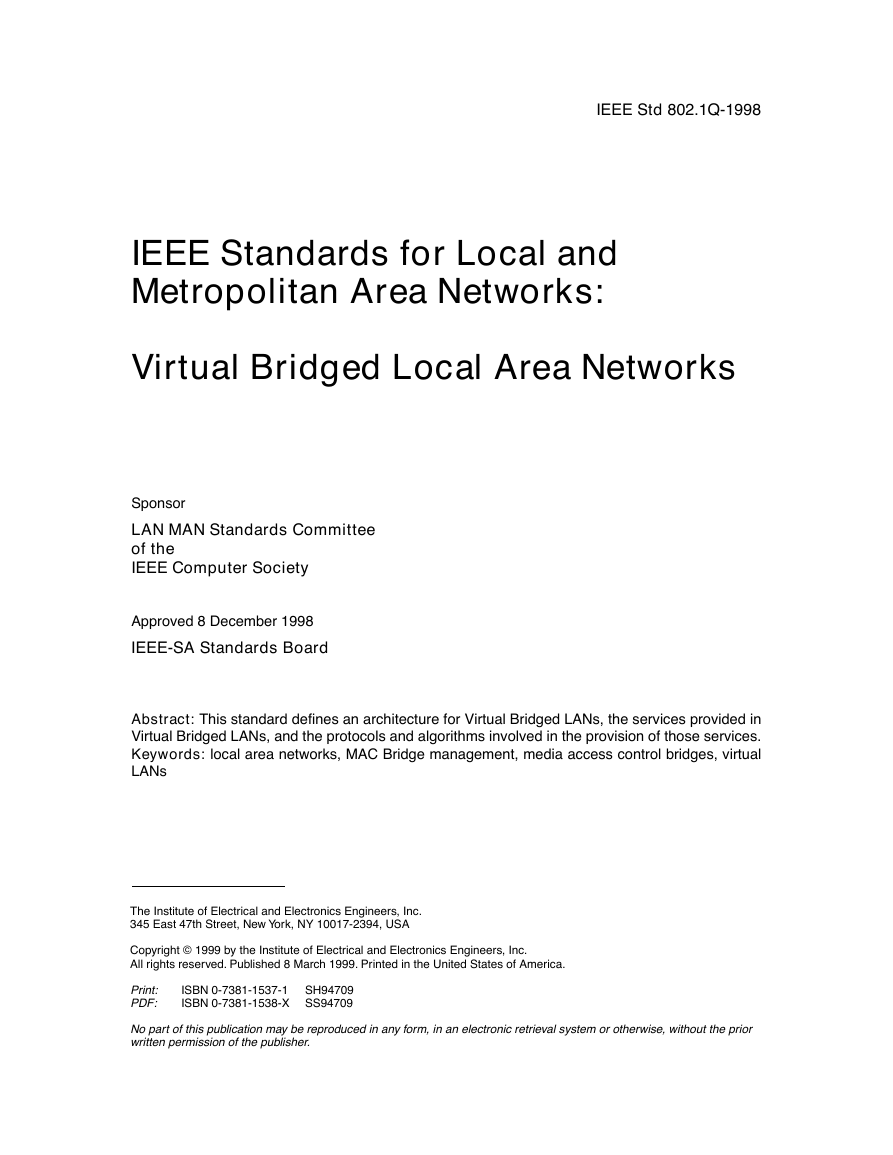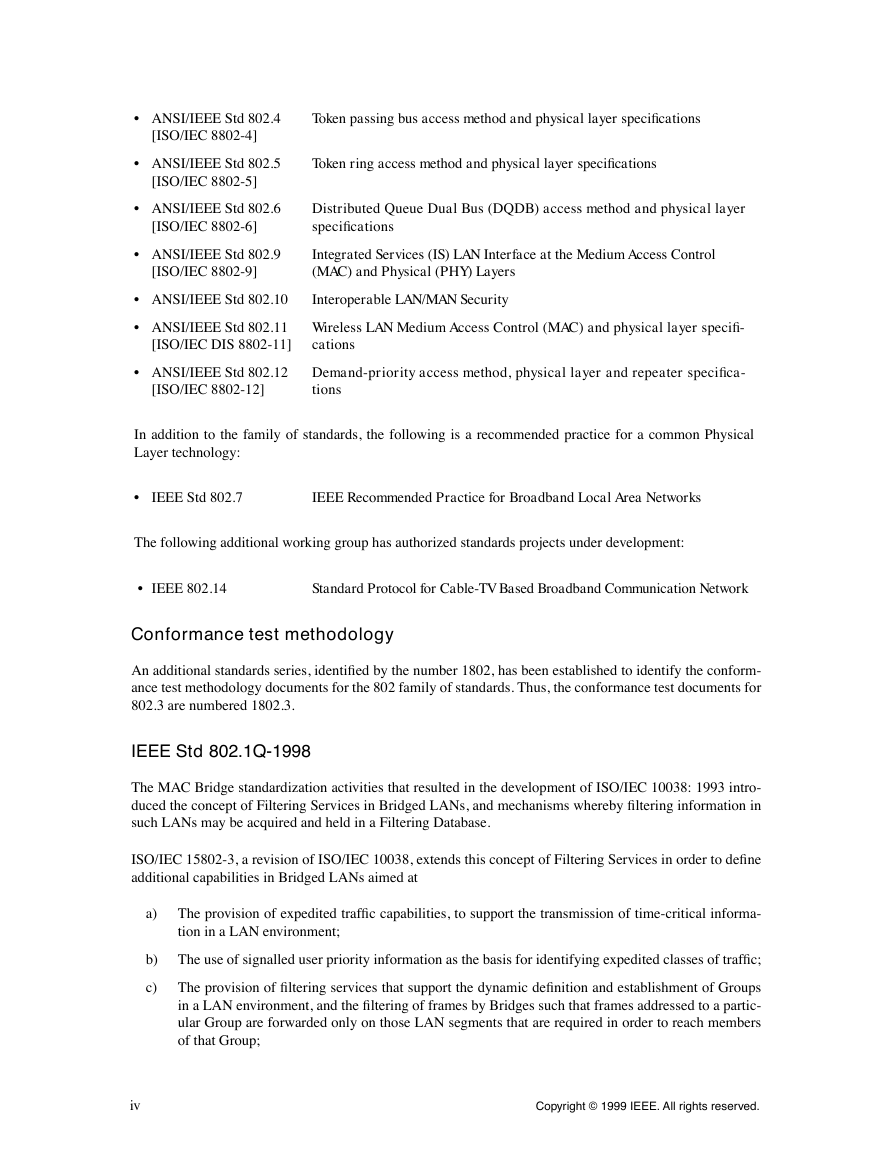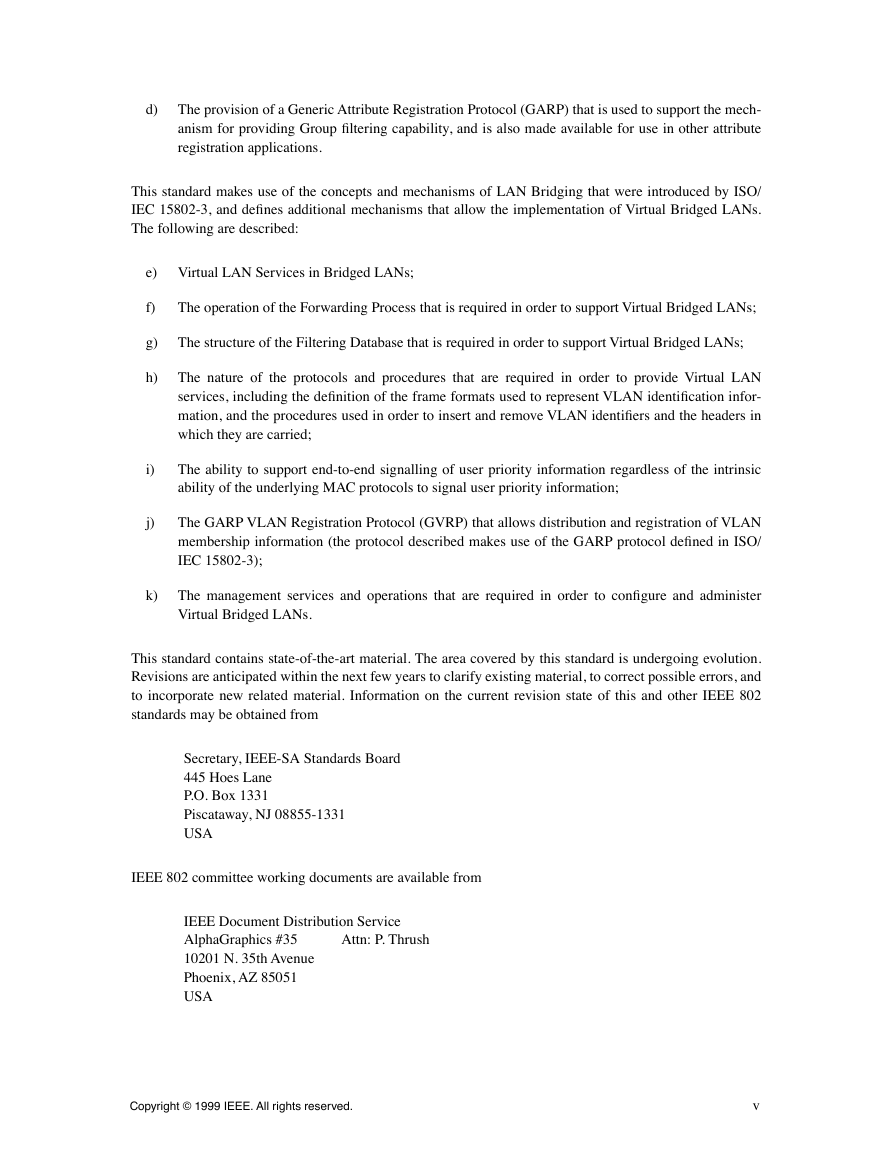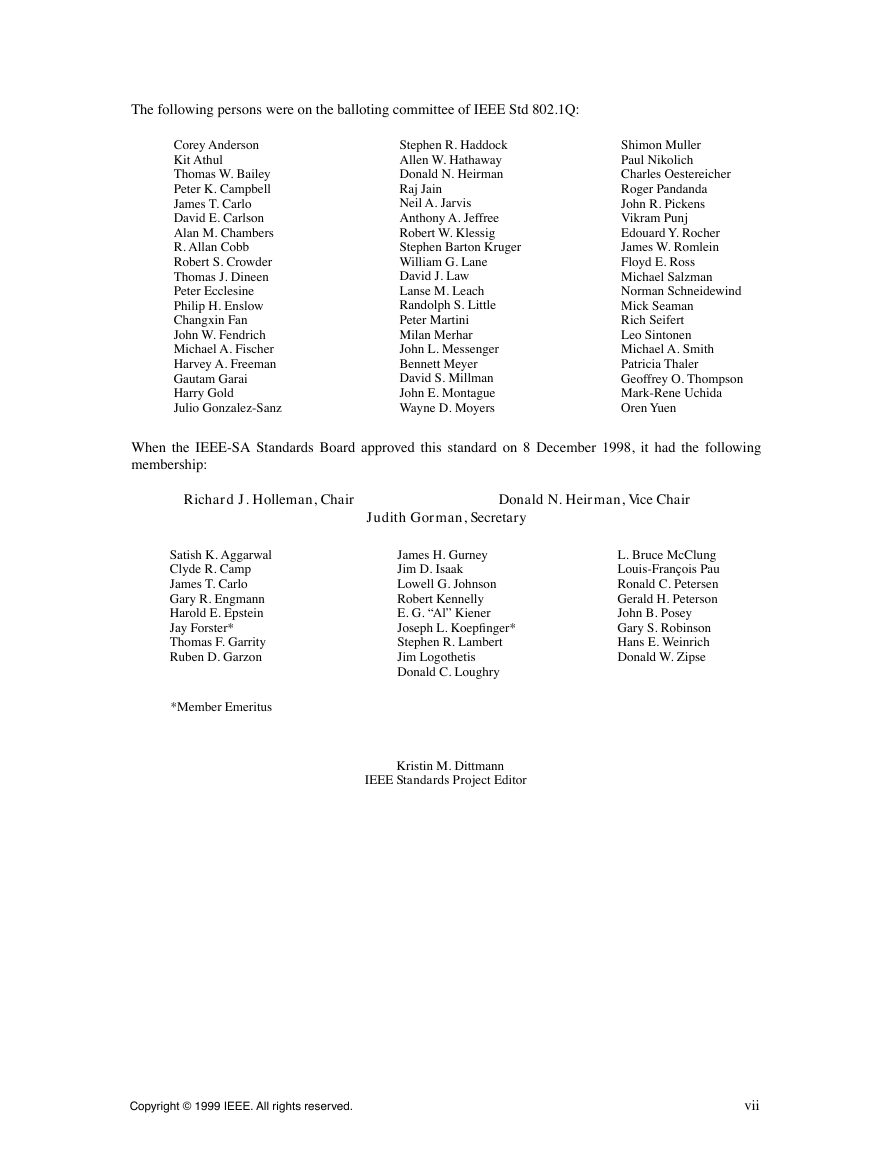IEEE Std 802.1Q-1998
IEEE Standards for Local and
Metropolitan Area Networks:
Virtual Bridged Local Area Networks
Sponsor
LAN MAN Standards Committee
of the
IEEE Computer Society
Approved 8 December 1998
IEEE-SA Standards Board
Abstract:
This standard defines an architecture for Virtual Bridged LANs, the services provided in
Virtual Bridged LANs, and the protocols and algorithms involved in the provision of those services.
Keywords:
local area networks, MAC Bridge management, media access control bridges, virtual
LANs
The Institute of Electrical and Electronics Engineers, Inc.
345 East 47th Street, New York, NY 10017-2394, USA
Copyright © 1999 by the Institute of Electrical and Electronics Engineers, Inc.
All rights reserved. Published 8 March 1999. Printed in the United States of America.
Print:
PDF:
ISBN 0-7381-1537-1 SH94709
ISBN 0-7381-1538-X SS94709
No part of this publication may be reproduced in any form, in an electronic retrieval system or otherwise, without the prior
written permission of the publisher.
�
IEEE Standards
documents are developed within the IEEE Societies and the Standards Coordinating Com-
mittees of the IEEE Standards Association (IEEE-SA) Standards Board. Members of the committees serve
voluntarily and without compensation. They are not necessarily members of the Institute. The standards
developed within IEEE represent a consensus of the broad expertise on the subject within the Institute as
well as those activities outside of IEEE that have expressed an interest in participating in the development of
the standard.
Use of an IEEE Standard is wholly voluntary. The existence of an IEEE Standard does not imply that there
are no other ways to produce, test, measure, purchase, market, or provide other goods and services related to
the scope of the IEEE Standard. Furthermore, the viewpoint expressed at the time a standard is approved and
issued is subject to change brought about through developments in the state of the art and comments
received from users of the standard. Every IEEE Standard is subjected to review at least every five years for
revision or reaffirmation. When a document is more than five years old and has not been reaffirmed, it is rea-
sonable to conclude that its contents, although still of some value, do not wholly reflect the present state of
the art. Users are cautioned to check to determine that they have the latest edition of any IEEE Standard.
Comments for revision of IEEE Standards are welcome from any interested party, regardless of membership
affiliation with IEEE. Suggestions for changes in documents should be in the form of a proposed change of
text, together with appropriate supporting comments.
Interpretations: Occasionally questions may arise regarding the meaning of portions of standards as they
relate to specific applications. When the need for interpretations is brought to the attention of IEEE, the
Institute will initiate action to prepare appropriate responses. Since IEEE Standards represent a consensus of
all concerned interests, it is important to ensure that any interpretation has also received the concurrence of a
balance of interests. For this reason, IEEE and the members of its societies and Standards Coordinating
Committees are not able to provide an instant response to interpretation requests except in those cases where
the matter has previously received formal consideration.
Comments on standards and requests for interpretations should be addressed to:
Secretary, IEEE-SA Standards Board
445 Hoes Lane
P.O. Box 1331
Piscataway, NJ 08855-1331
USA
Note: Attention is called to the possibility that implementation of this standard may
require use of subject matter covered by patent rights. By publication of this standard,
no position is taken with respect to the existence or validity of any patent rights in
connection therewith. The IEEE shall not be responsible for identifying patents for
which a license may be required by an IEEE standard or for conducting inquiries into
the legal validity or scope of those patents that are brought to its attention.
Authorization to photocopy portions of any individual standard for internal or personal use is granted by the
Institute of Electrical and Electronics Engineers, Inc., provided that the appropriate fee is paid to Copyright
Clearance Center. To arrange for payment of licensing fee, please contact Copyright Clearance Center, Cus-
tomer Service, 222 Rosewood Drive, Danvers, MA 01923 USA; (978) 750-8400. Permission to photocopy
portions of any individual standard for educational classroom use can also be obtained through the Copy-
right Clearance Center.
�
Introduction to IEEE Std 802.1Q-1998
(This introduction is not part of IEEE Std 802.1Q-1998, IEEE Standards for Local and Metropolitan Area Networks:
Virtual Bridged Local Area Networks.)
This standard is part of a family of standards for local and metropolitan area networks. The relationship
between the standard and other members of the family is shown below. (The numbers in the figure refer to
IEEE standard numbers.)
I
Y
T
R
U
C
E
S
0
1
2
0
8
.
I
*
E
R
U
T
C
E
T
H
C
R
A
&
W
E
V
R
E
V
O
2
0
8
I
T
N
E
M
E
G
A
N
A
M
1
.
2
0
8
802.2 LOGICAL LINK CONTROL
802.1 BRIDGING
DATA
LINK
LAYER
802.3
MEDIUM
ACCESS
802.4
MEDIUM
ACCESS
802.5
MEDIUM
ACCESS
802.6
MEDIUM
ACCESS
802.9
MEDIUM
ACCESS
802.11
MEDIUM
ACCESS
802.12
MEDIUM
ACCESS
802.14
MEDIUM
ACCESS
802.3
PHYSICAL
802.4
PHYSICAL
802.5
PHYSICAL
802.6
PHYSICAL
802.9
PHYSICAL
802.11
PHYSICAL
802.12
PHYSICAL
802.14
PHYSICAL
PHYSICAL
LAYER
* Formerly IEEE Std 802.1A.
This family of standards deals with the Physical and Data Link layers as defined by the International Organi-
zation for Standardization (ISO) Open Systems Interconnection (OSI) Basic Reference Model (ISO/IEC
7498-1: 1994). The access standards define seven types of medium access technologies and associated
physical media, each appropriate for particular applications or system objectives. Other types are under
investigation.
The standards defining the technologies noted above are as follows:
•
IEEE Std 802
Overview and Architecture.
ily of IEEE 802 Standards.
This standard provides an overview to the fam-
• ANSI/IEEE Std 802.1B
and 802.1k
[ISO/IEC 15802-2]
LAN/MAN Management.
ture, and services and protocol elements for use in a LAN/MAN environ-
ment for performing remote management.
Defines an OSI management-compatible architec-
• ANSI/IEEE Std 802.1D
[ISO/IEC 15802-3]
Specifies an architecture and protocol
Media Access Control
(MAC) Bridges.
for the interconnection of IEEE 802 LANs below the MAC service boundary.
• ANSI/IEEE Std 802.1E
[ISO/IEC 15802-4]
System Load Protocol.
of management concerned with the loading of systems on IEEE 802 LANs.
Specifies a set of services and protocol for those aspects
• ANSI/IEEE Std 802.1F
Common Definitions and Procedures for IEEE 802 Management Information
• ANSI/IEEE Std 802.1G
[ISO/IEC 15802-5]
Remote Media Access Control
(MAC) bridging
interconnection, using non-LAN communication technologies, of geographically
separated IEEE 802 LANs below the level of the logical link control protocol.
. Specifies extensions for the
• ANSI/IEEE Std 802.2
Logical link control
[ISO/IEC 8802-2]
• ANSI/IEEE Std 802.3
CSMA/CD access method and physical layer specifications
[ISO/IEC 8802-3]
Copyright © 1999 IEEE. All rights reserved.
iii
�
• ANSI/IEEE Std 802.4
Token passing bus access method and physical layer specifications
[ISO/IEC 8802-4]
• ANSI/IEEE Std 802.5
Token ring access method and physical layer specifications
[ISO/IEC 8802-5]
• ANSI/IEEE Std 802.6
[ISO/IEC 8802-6]
Distributed Queue Dual Bus (DQDB) access method and physical layer
specifications
• ANSI/IEEE Std 802.9
[ISO/IEC 8802-9]
Integrated Services (IS) LAN Interface at the Medium Access Control
(MAC) and Physical (PHY) Layers
• ANSI/IEEE Std 802.10
Interoperable LAN/MAN Security
• ANSI/IEEE Std 802.11
[ISO/IEC DIS 8802-11]
Wireless LAN Medium Access Control (MAC) and physical layer specifi-
cations
• ANSI/IEEE Std 802.12
[ISO/IEC 8802-12]
Demand-priority access method, physical layer and repeater specifica-
tions
In addition to the family of standards, the following is a recommended practice for a common Physical
Layer technology:
•
IEEE Std 802.7
IEEE Recommended Practice for Broadband Local Area Networks
The following additional working group has authorized standards projects under development:
• IEEE 802.14
Standard Protocol for Cable-TV Based Broadband Communication Network
Conformance test methodology
An additional standards series, identified by the number 1802, has been established to identify the conform-
ance test methodology documents for the 802 family of standards. Thus, the conformance test documents for
802.3 are numbered 1802.3.
IEEE Std 802.1Q-1998
The MAC Bridge standardization activities that resulted in the development of ISO/IEC 10038: 1993 intro-
duced the concept of Filtering Services in Bridged LANs, and mechanisms whereby filtering information in
such LANs may be acquired and held in a Filtering Database.
ISO/IEC 15802-3, a revision of ISO/IEC 10038, extends this concept of Filtering Services in order to define
additional capabilities in Bridged LANs aimed at
a)
b)
c)
iv
The provision of expedited traffic capabilities, to support the transmission of time-critical informa-
tion in a LAN environment;
The use of signalled user priority information as the basis for identifying expedited classes of traffic;
The provision of filtering services that support the dynamic definition and establishment of Groups
in a LAN environment, and the filtering of frames by Bridges such that frames addressed to a partic-
ular Group are forwarded only on those LAN segments that are required in order to reach members
of that Group;
Copyright © 1999 IEEE. All rights reserved.
�
d)
The provision of a Generic Attribute Registration Protocol (GARP) that is used to support the mech-
anism for providing Group filtering capability, and is also made available for use in other attribute
registration applications.
This standard makes use of the concepts and mechanisms of LAN Bridging that were introduced by ISO/
IEC 15802-3, and defines additional mechanisms that allow the implementation of Virtual Bridged LANs.
The following are described:
e) Virtual LAN Services in Bridged LANs;
f)
g)
h)
i)
j)
k)
The operation of the Forwarding Process that is required in order to support Virtual Bridged LANs;
The structure of the Filtering Database that is required in order to support Virtual Bridged LANs;
The nature of the protocols and procedures that are required in order to provide Virtual LAN
services, including the definition of the frame formats used to represent VLAN identification infor-
mation, and the procedures used in order to insert and remove VLAN identifiers and the headers in
which they are carried;
The ability to support end-to-end signalling of user priority information regardless of the intrinsic
ability of the underlying MAC protocols to signal user priority information;
The GARP VLAN Registration Protocol (GVRP) that allows distribution and registration of VLAN
membership information (the protocol described makes use of the GARP protocol defined in ISO/
IEC 15802-3);
The management services and operations that are required in order to configure and administer
Virtual Bridged LANs.
This standard contains state-of-the-art material. The area covered by this standard is undergoing evolution.
Revisions are anticipated within the next few years to clarify existing material, to correct possible errors, and
to incorporate new related material. Information on the current revision state of this and other IEEE 802
standards may be obtained from
Secretary, IEEE-SA Standards Board
445 Hoes Lane
P.O. Box 1331
Piscataway, NJ 08855-1331
USA
IEEE 802 committee working documents are available from
IEEE Document Distribution Service
AlphaGraphics #35
10201 N. 35th Avenue
Phoenix, AZ 85051
USA
Attn: P. Thrush
Copyright © 1999 IEEE. All rights reserved.
v
�
Participants
The following is a list of participants in the Interworking activities of the IEEE 802.1 Working Group.
Voting members at the time of publication are marked with an asterisk (*).
William P. Lidinsky,
Chair*
Mick Seaman,
Chair, Interworking Task Group*
Editing Team:
Anil Rijsinghani
*,
,
Tony Jeffree
*
Michele Wright
Richard Hausman
*,
Coordinating Editor
*,
Paul Langille
*,
P. J. Singh
*
Steve Adams*
Stephen Ades
Ken Alonge
Floyd Backes*
John Bartlett*
Les Bell*
Avner Ben-Dor
Michael Berger*
James S. Binder*
David Brady
Martin Brewer
Bill Bunch*
Bob Cardinal
Paul Carroll*
Jeffrey Catlin*
Dennis Cave
Alan Chambers*
Steve Chan
David W. Chang*
Ken Chapman
Hon Wah Chin*
Chi Chong
Chris Christ*
Paul Congdon*
Glenn Connery*
David Cullerot*
Ted Davies*
Andy Davis
David Delaney*
Prakash Desai
Jeffrey Dietz*
Kurt Dobbins
Peter Ecclesine*
J. J. Ekstrom*
Norman W. Finn*
Yishai Fraenkel
Paul Frantz
Lars Henrik Frederiksen*
Anoop Ghanwani*
John Grinham
Steve Haddock
Sharam Hakimi*
John Hart*
Scott Harvell
Wayne Hathaway
Vic Hayes
David Head*
Gaby Hecht
Deepak Hegde*
Ariel Hendel
John Hickey
David Hollender
Steve Horowitz*
Michelle Hsiung
Rita Hunt
David Husak
Altaf Hussain*
Vipin K. Jain*
Neil Jarvis
Allen Kasey
Toyoyuki Kato*
Hal Keen*
Kevin Ketchum*
Keith Klamm*
Bruce Kling*
Walter Knitl
Dan Krent*
Paul Kummer
Paul Lachapelle*
Bill Lane
Johann Lindmeyr*
Gary Littleton
Robert D. Love
Andy Luque
Peter Martini
Keith McCloghrie
Martin McNealis
Milan Merhar*
John Messenger*
Colin Mick
Amol Mitra
Yaron Nachman*
Krishna Narayanaswamy*
Paul Nikolich
Lawrence Ng*
Henry Ngai*
Eugene O’Neil
Satoshi Obara*
Toshio Ooka*
Jörg Ottensmeyer*
Luc Pariseau*
Yonadav Perry
John Pickens*
Gideon Prat
Kirk Preiss
Steve Ramberg*
Shlomo Reches*
Dick Reohr
James Richmond*
Doug Ruby
Ray Samora
Ayman Sayed*
Rich Seifert
Lee Sendelbach*
Himanshu Shah*
Phil Simmons*
K. Karl Shimada
Fred Shu
Rosemary V. Slager*
Alexander Smith*
Andrew Smith*
Larry Stefani*
Stuart Soloway*
Sundar Subramaniam*
Richard Sweatt
Robin Tasker*
Fouad Tobagi
Naoki Tsukutari
Dhadesugoor Vaman
Steve Van Seters*
Dono van-Mierop*
John Wakerly*
Peter Wang*
Philip Wang
Y. C. Wang*
Trevor Warwick*
Bob Watson
Alan Weissberger
Glenn Wenig
Keith Willette*
Michael Witkowski*
Edward Wong*
Michael D. Wright*
Allen Yu*
Wayne Zakowski*
vi
Copyright © 1999 IEEE. All rights reserved.
�
The following persons were on the balloting committee of IEEE Std 802.1Q:
Corey Anderson
Kit Athul
Thomas W. Bailey
Peter K. Campbell
James T. Carlo
David E. Carlson
Alan M. Chambers
R. Allan Cobb
Robert S. Crowder
Thomas J. Dineen
Peter Ecclesine
Philip H. Enslow
Changxin Fan
John W. Fendrich
Michael A. Fischer
Harvey A. Freeman
Gautam Garai
Harry Gold
Julio Gonzalez-Sanz
Stephen R. Haddock
Allen W. Hathaway
Donald N. Heirman
Raj Jain
Neil A. Jarvis
Anthony A. Jeffree
Robert W. Klessig
Stephen Barton Kruger
William G. Lane
David J. Law
Lanse M. Leach
Randolph S. Little
Peter Martini
Milan Merhar
John L. Messenger
Bennett Meyer
David S. Millman
John E. Montague
Wayne D. Moyers
Shimon Muller
Paul Nikolich
Charles Oestereicher
Roger Pandanda
John R. Pickens
Vikram Punj
Edouard Y. Rocher
James W. Romlein
Floyd E. Ross
Michael Salzman
Norman Schneidewind
Mick Seaman
Rich Seifert
Leo Sintonen
Michael A. Smith
Patricia Thaler
Geoffrey O. Thompson
Mark-Rene Uchida
Oren Yuen
When the IEEE-SA Standards Board approved this standard on 8 December 1998, it had the following
membership:
Richard J. Holleman,
Chair
Donald N. Heirman,
Vice Chair
Judith Gorman,
Secretary
Satish K. Aggarwal
Clyde R. Camp
James T. Carlo
Gary R. Engmann
Harold E. Epstein
Jay Forster*
Thomas F. Garrity
Ruben D. Garzon
*Member Emeritus
James H. Gurney
Jim D. Isaak
Lowell G. Johnson
Robert Kennelly
E. G. “Al” Kiener
Joseph L. Koepfinger*
Stephen R. Lambert
Jim Logothetis
Donald C. Loughry
L. Bruce McClung
Louis-François Pau
Ronald C. Petersen
Gerald H. Peterson
John B. Posey
Gary S. Robinson
Hans E. Weinrich
Donald W. Zipse
Kristin M. Dittmann
IEEE Standards Project Editor
Copyright © 1999 IEEE. All rights reserved.
vii
�
Contents
1.
Overview.............................................................................................................................................. 1
2.
3.
4.
5.
1.1
1.2
1.3
Scope........................................................................................................................................ 1
VLAN aims and benefits ......................................................................................................... 1
Relationship with ISO/IEC 15802-3........................................................................................ 2
References............................................................................................................................................ 4
Definitions ........................................................................................................................................... 7
3.1
3.2
3.3
3.4
3.5
3.6
3.7
3.8
3.9
3.10
3.11
Ethernet Type-encoding........................................................................................................... 7
Logical Link Control (LLC) encoding..................................................................................... 7
Frame ....................................................................................................................................... 7
Frame relay .............................................................................................................................. 7
Independent Virtual Local Area Network (VLAN) Learning (IVL) ....................................... 7
Independent Virtual Local Area Network (VLAN) Learning (IVL) Bridge ........................... 7
Legacy region .......................................................................................................................... 8
Priority-tagged frame............................................................................................................... 8
Shared Virtual Local Area Network (VLAN) Learning (SVL)............................................... 8
Shared Virtual Local Area Network (VLAN) Learning (SVL) Bridge................................... 8
Shared Virtual Local Area Network (VLAN) Learning (SVL)/Independent Virtual
Local Area Network (VLAN) Learning (IVL) Bridge ............................................................ 8
Tagged frame ........................................................................................................................... 8
3.12
3.13
Tag header................................................................................................................................ 8
3.14 Untagged frame............................................................................................................. ........... 9
3.15 Virtual Bridged Local Area Network (LAN) .......................................................................... 9
3.16 Virtual Local Area Network (VLAN) ..................................................................................... 9
3.17 VLAN-aware ........................................................................................................................... 9
3.18 VLAN-tagged frame ................................................................................................................ 9
3.19 VLAN-unaware ............................................................................................................... ........ 9
3.20
Terms used in ISO/IEC 15802-3 ............................................................................................. 9
Abbreviations..................................................................................................................................... 10
Conformance...................................................................................................................................... 11
Static conformance requirements........................................................................................... 11
5.1
Options................................................................................................................................... 12
5.2
Protocol Implementation Conformance Statement (PICS).................................................... 12
5.3
5.4 MAC-specific bridging methods............................................................................................ 12
6.
Architectural overview ...................................................................................................................... 13
6.1
6.2
6.3
6.4
6.5
6.6
6.7
Configuration ......................................................................................................................... 13
Distribution of configuration information ............................................................................. 13
Relay ...................................................................................................................................... 13
Filtering Database architecture .............................................................................................. 14
VLAN classification .............................................................................................................. 15
Rules for tagging frames........................................................................................................ 16
Spanning Tree ........................................................................................................................ 16
viii
Copyright © 1999 IEEE. All rights reserved.
�
















 2023年江西萍乡中考道德与法治真题及答案.doc
2023年江西萍乡中考道德与法治真题及答案.doc 2012年重庆南川中考生物真题及答案.doc
2012年重庆南川中考生物真题及答案.doc 2013年江西师范大学地理学综合及文艺理论基础考研真题.doc
2013年江西师范大学地理学综合及文艺理论基础考研真题.doc 2020年四川甘孜小升初语文真题及答案I卷.doc
2020年四川甘孜小升初语文真题及答案I卷.doc 2020年注册岩土工程师专业基础考试真题及答案.doc
2020年注册岩土工程师专业基础考试真题及答案.doc 2023-2024学年福建省厦门市九年级上学期数学月考试题及答案.doc
2023-2024学年福建省厦门市九年级上学期数学月考试题及答案.doc 2021-2022学年辽宁省沈阳市大东区九年级上学期语文期末试题及答案.doc
2021-2022学年辽宁省沈阳市大东区九年级上学期语文期末试题及答案.doc 2022-2023学年北京东城区初三第一学期物理期末试卷及答案.doc
2022-2023学年北京东城区初三第一学期物理期末试卷及答案.doc 2018上半年江西教师资格初中地理学科知识与教学能力真题及答案.doc
2018上半年江西教师资格初中地理学科知识与教学能力真题及答案.doc 2012年河北国家公务员申论考试真题及答案-省级.doc
2012年河北国家公务员申论考试真题及答案-省级.doc 2020-2021学年江苏省扬州市江都区邵樊片九年级上学期数学第一次质量检测试题及答案.doc
2020-2021学年江苏省扬州市江都区邵樊片九年级上学期数学第一次质量检测试题及答案.doc 2022下半年黑龙江教师资格证中学综合素质真题及答案.doc
2022下半年黑龙江教师资格证中学综合素质真题及答案.doc